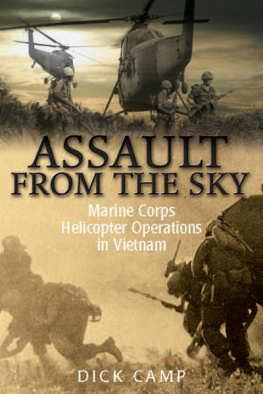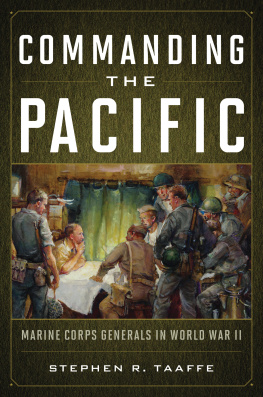
Published in the United States of America and Great Britain in 2013 by
CASEMATE PUBLISHERS
908 Darby Road, Havertown, PA 19083
and
10 Hythe Bridge Street, Oxford, OX1 2EW
Copyright 2013 Dick Camp
ISBN 978-1-61200-128-9
Digital Edition: ISBN 978-1-61200-140-1
Cataloging-in-publication data is available from the Library of Congress and
the British Library.
All rights reserved. No part of this book may be reproduced or transmitted in
any form or by any means, electronic or mechanical including photocopying,
recording or by any information storage and retrieval system, without permission
from the Publisher in writing.
10 9 8 7 6 5 4 3 2 1
Printed and bound in the United States of America.
For a complete list of Casemate titles please contact:
CASEMATE PUBLISHERS (US)
Telephone (610) 853-9131, Fax (610) 853-9146
E-mail:
CASEMATE PUBLISHERS (UK)
Telephone (01865) 241249, Fax (01865) 794449
E-mail:
HELICOPTERS ARE DIFFERENT
The thing is, helicopters are different from planes. An airplane by its nature wants to fly and if not interfered with too strongly by unusual events or by a deliberately incompetent pilot, it will fly. A helicopter does not want to fly. It is maintained in the air by a variety of forces and controls, working in opposition to each other; and if there is any disturbance in the delicate balance, the helicopter stops flying immediately and disastrously. There is no such thing as a gliding helicopter. This is why being a helicopter pilot is so different from being an airplane pilot; and why, in generality, airplane pilots are open, clear-eyed, buoyant extroverts and helicopter pilots are brooders, introspective anticipators of trouble. They know if anything bad has not happened it is about to.Harry Reasoner, ABC Evening News, 16 February 1971

PROLOGUE
A drenaline surged through my blood stream as black puffballs of an tiaircraft fire erupted in the distance. It was a wake-up call, the North Vietnamese were alive and well in the Ashau!
I was sitting on the outboard jump seat of a U.S. Army Huey; its side door was wide open. My heart was in my mouth as I stared down at the jungle several thousand feet below. It was not a pleasant experience! Several minutes earlier I had seen a CH-54 Flying Crane carrying a small bulldozer take a hit and crash in a great ball of fire. Neither was my confidence bolstered by the fact that our pilot, the fifty-plus-year-old Army Maj. Gen. John J. Tolson III, had only gone through the short, senior officer flight course at Fort Rucker. Helicopters are unforgivingexperience counts! I glanced to my right and observed my boss, Marine Maj. Gen. Raymond G. Davis, totally absorbed in the action. Operation Delaware, the air assault into the North Vietnamese Armys (NVA) backyard was being conducted by the 1st Cavalry Division (Airmobile), the Armys elite helicopter-borne assault division, and we had been invited to observe it. The assault was a classic helicopter strike. The landing zone had been prepped by B-52 and Marine and Air Force fighter-bombers followed by the main assault force, UH-1H troop-carrying helicopters, escorted by rotary-wing gunships, while command and control helicopters circled overhead monitoring the tactical situation on the ground. The operation was the Cavs typical way of fighting. Major General Davis intended to introduce this concept of high mobility into the 3rd Marine Divisions scheme of maneuver when he assumed command.
General Davis used the time before taking command of the division to study the Armys use of helicopters. He took every opportunity to discuss operational matters with the Cavs senior leadership and visit their units in the field. As his aide de camp, I was along for the ride, and the assault into the Ashau Valley was one of those occasions I would have gladly passed up. Regardless of my trepidation, the view at ten thousand feet over the valley was extraordinary. The sky was literally black with helicopters: aerial rocket artillery (ARA) from the 2nd Battalion, 20th Field Artillery Regiments gunships was pounding enemy antiaircraft emplacements; the 1st Squadron, 9th Cavalrys aero-weapons, aero-scout, and aero-rifles choppers (known as Reds, Whites, and Blues, respectively) flitted through the sky stalking enemy personnel as the troop-carrying birds arrived in waves. Sensational! That day in 1968 confirmed in my mind that Vietnam was truly a helicopter war.
In June, two months later, I accompanied General Davis to the 1st Cavs headquarters at Camp Evans. On that particular day our regular bird, a Huey, was unavailable so we were being flown by a Marine Corps UH-34D helicopter, a model which was being phased out by the newer turbine-driven CH-46A. After shutting down the engine, the pilots climbed down from the cockpit and joined the crew chief and gunner waiting for the return of the general. Before long a large crowd of young Army warrant officer pilots gathered to see the relic that their fathers had flown many years before. They were amazed that the ancient bird was still in service; the Army had replaced them at least a decade before. The UH-34D, known affectionately as the Dog, had first entered service in the late 1950s and had served as the mainstay of the Corps medium helicopter lift for over a decade and a half. In March 1966 the Vertol CH-46 Sea Knight, known colloquially as the Phrog, started arriving in Vietnam, relegating the Dogs to an increasingly minor role.
The Phrogs were a Godsend to the grunts (infantrymen) because they could carry a full squad, compared to the Dogs five or six combat-loaded Marines. Regrettably, the 46 was not quite ready for prime time. In September 1967, the entire fleet was grounded because of a series of unexplained crashes. An observer saw one of the crashes and described seeing the tail fly off in flight; the crew died in the crash. An investigation found that structural failures were occurring in the after pylon. As a result of the grounding, ap -proximately half the Marine Corps tactical/logistic airlift in Vietnam was lost until the problem was fixed and the CH-46s were placed back in service. To take up the gap, the tried and true UH-34Ds were given a new lease on life.
Most Marines, particularly my infantry contemporaries, were beneficiaries of helicopter support. The birds carried the grunt into combat, provided him with rations, ammunition, close air support, and carried him out of battle, dead or alive. I, for one, can never forget the stench of JP-4 (jet fuel), the hot blast of engine exhaust, the drip of hydraulic fluid, the orange-colored nylon seats, and the leap of faith jumping off the ramp off a hovering 46 into the ten-foot high elephant grass... and the medevac helicopters promise of life. The memory of holding a critically wounded Marines head in my hands, and praying for the life flight, is still an open wound.

The first U.S. Marine Corps helicopter deployment began in 1962 and ended with the evacuation of Saigon in 1975. During that decade of Americas involvement in South Vietnam over four hundred Marine Corps helicopters were lost in combat and operational accidents taking some eight hundred passengers and crewmen with them. Assault from the Sky: U.S. Marine Helicopters in Vietnam Combat is an account of the bravery and sacrifice of the helicopter flight crews during that involvement.
This book is organized into three parts that correspond to the American buildup (19621966), increasingly heavy combat (19671969), and the final evacuation (1975) of South Vietnam. Each part is comprised of several chapters that provide the reader with examples of the bravery, dedication and sacrifice of Marine Corps aircrews in support of their infantry brethren.
Next page















